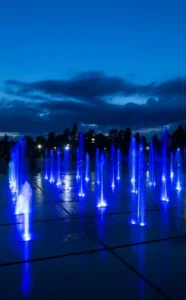- Product Knowledge
Understanding CRI (Color Rendering Index)
The Color Rendering Index (CRI) is a critical metric in the world of lighting, representing how accurately a light source renders colors compared to natural light. Understanding CRI is essential for choosing the right lighting for various applications, from residential and commercial settings to photography and art galleries.
What is Color Rendering Index (CRI)?

CRI is a quantitative measure that describes how well a light source can reveal the true colors of objects, similar to natural sunlight. Developed by the International Commission on Illumination (CIE), CRI is expressed as a number on a scale from 0 to 100. A higher CRI indicates better color rendering capability, with natural sunlight having a CRI of 100.
How CRI is Measured
CRI is measured by comparing the color rendering of a light source to a reference source with a similar color temperature. The process involves illuminating a set of color samples with the test light and the reference light. The differences in color rendering are calculated, and the average difference is used to determine the CRI value.
The Importance of CRI in Different Applications
- Residential Lighting: High CRI lighting enhances the appearance of interiors, making colors look more vibrant and natural.
- Commercial Lighting: In retail environments, high CRI lighting improves product display, making items more appealing to customers.
- Industrial Lighting: Accurate color rendering is crucial in industries where color differentiation is important, such as manufacturing and quality control.
- Photography and Film: High CRI lighting ensures that colors are captured accurately, crucial for producing high-quality images and videos.
- Art Galleries and Museums: High CRI lighting preserves the true colors of artworks, providing viewers with an authentic visual experience.
CRI vs. Other Lighting Metrics
- Color Temperature (CCT): While CRI measures color accuracy, CCT describes the color appearance of the light source, ranging from warm (yellow/red) to cool (blue).
- Color Quality Scale (CQS): CQS is a newer metric that improves upon CRI by evaluating more color samples and providing a more comprehensive assessment of color quality.
- R9 Value and TM-30-15: R9 represents the rendering of strong red colors, which are not included in the CRI calculation. TM-30-15 is an advanced metric providing more detailed color rendering information.
Advantages of High CRI Lighting
- Enhanced Color Accuracy: High CRI lighting makes colors appear more natural and vibrant, crucial for tasks requiring precise color recognition.
- Better Visual Comfort: Accurate color rendering reduces eye strain and improves visual comfort, especially in work environments.
- Improved Mood and Productivity: Studies have shown that high-quality lighting can positively affect mood and productivity, creating a more pleasant and efficient atmosphere.
Limitations of CRI
Despite its widespread use, CRI has limitations. It does not account for all aspects of color rendering, such as saturation and hue shift. Additionally, it does not measure the rendering of saturated colors well, leading to the development of alternative metrics like TM-30-15.
How to Choose the Right CRI for Your Needs
- Recommended CRI Levels: For residential and commercial lighting, a CRI of 80 or above is generally recommended. For applications requiring precise color rendering, such as photography or art display, a CRI of 90 or above is preferable.
- Reading Lighting Specifications: Understanding CRI ratings in product specifications helps in selecting the appropriate lighting for different environments.
CRI in LED Lighting
LED technology has significantly improved in recent years, with many high-CRI LED products available in the market. LEDs with high CRI offer excellent color rendering, energy efficiency, and long lifespan, making them a popular choice for various lighting applications.
Future Trends in CRI and Lighting Quality
The future of lighting quality metrics is evolving, with innovations focusing on more comprehensive assessments of color rendering. Metrics like TM-30-15 and CQS are gaining traction, providing more detailed and accurate evaluations of light quality.
Frequently Asked Questions
A CRI rating of 80 or above is generally recommended for home lighting to ensure natural and vibrant color rendering.
Yes, high CRI lighting can improve mood and productivity by providing better visual comfort and accurate color representation.
High CRI lighting ensures accurate color rendering in photographs, essential for producing high-quality images.
Yes, alternatives like Color Quality Scale (CQS) and TM-30-15 offer more comprehensive assessments of light quality.
High CRI lighting preserves the true colors of artworks, providing viewers with an authentic and accurate visual experience.
CRI is a vital metric for assessing the quality of light sources and their ability to render colors accurately. Understanding CRI and its implications helps in choosing the right lighting for various applications, enhancing visual experiences and ensuring accurate color representation.



